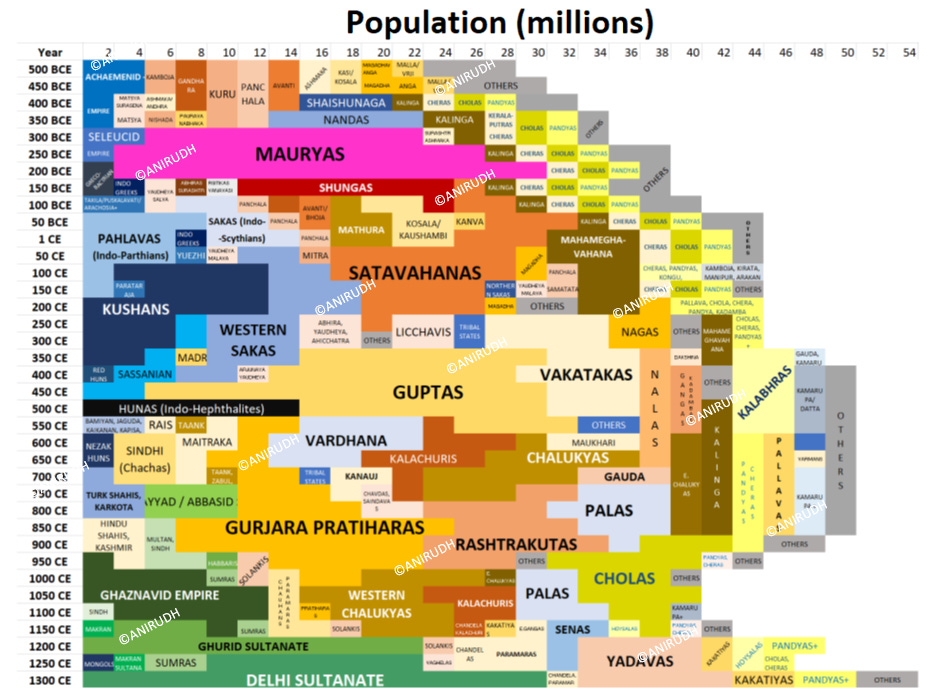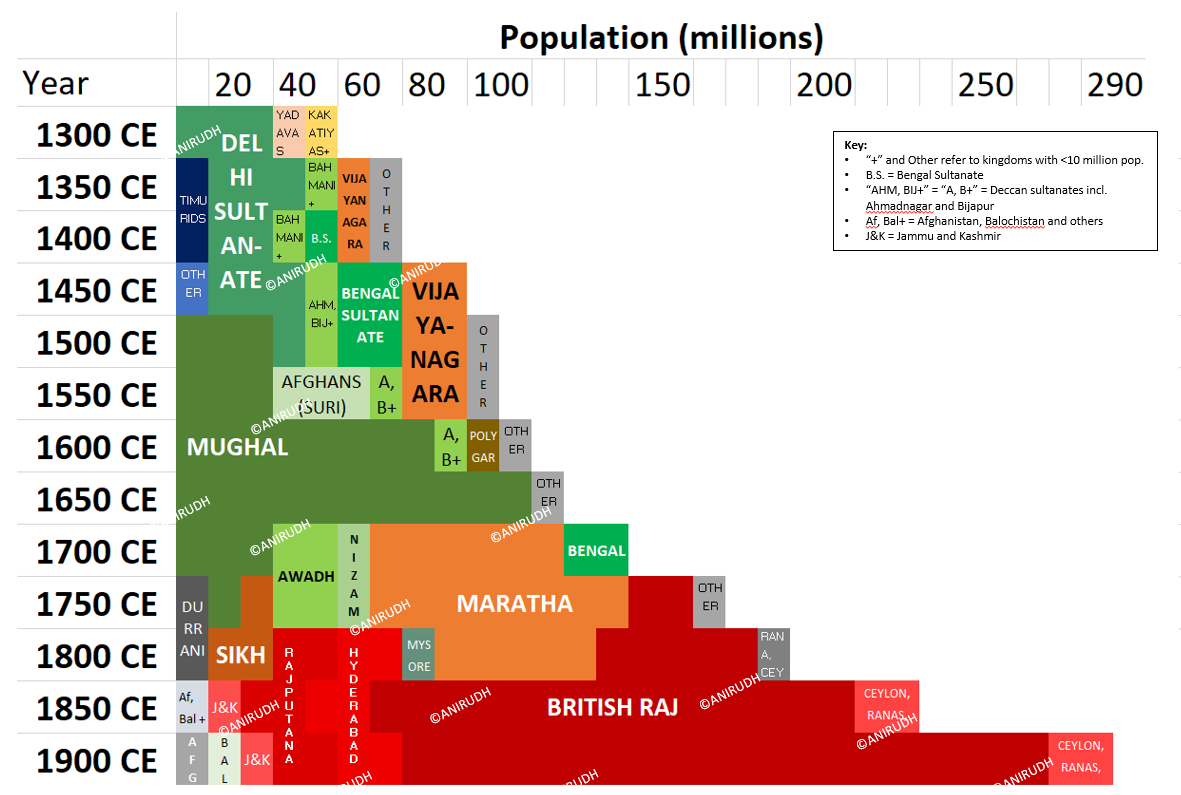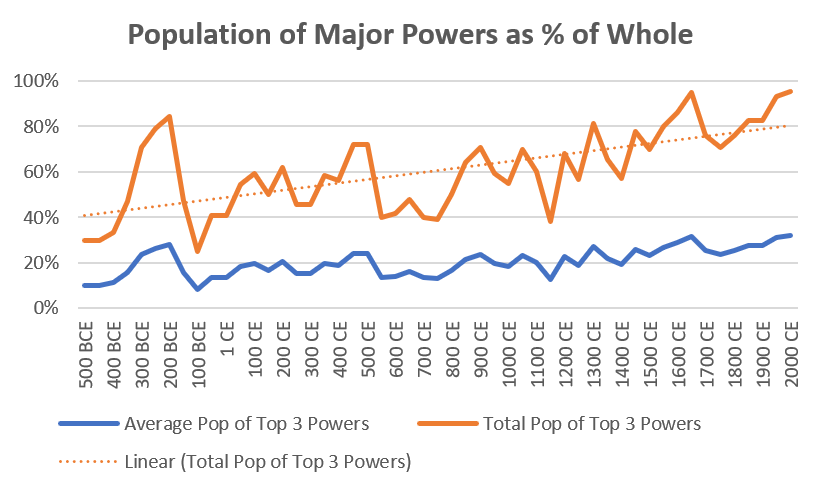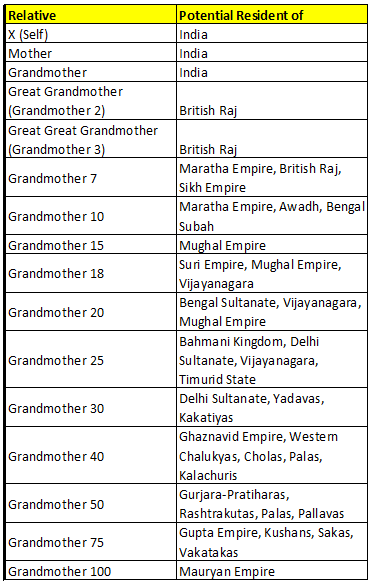Indian Empires in Population and Time
A snapshot of the subcontinent's ancestors as citizens of historical empires and kingdoms.
With the unexpected response I received on the prequel to this post (Indian Empires in Space and Time) came also a stream of questions and suggestions, including:
Should we not study empires in terms of their population, and not in terms of their expanse?,
What has impacted modern culture and systems more - vast but sparsely populated empires, or dense but small kingdoms? Is there any way to quantify this?, and
The Maratha empire at its peak had a lot more subjects than the Delhi Sultanate, but your analysis doesn’t capture this!
So during this Pitru Paksha (पितृ पक्ष, or “fortnight of the ancestors”) - known usually as Shraddh and Mahalaya, when millions of Hindus pay homage to their ancestors (Pitrus) - I attempt to address these questions by arresting the temptation to indulge in spatial thinking, and thinking in terms of our Pitrus instead.
So the question changes from “How vast was X empire?” to “How many of our ancestors lived in X empire?” The following example illuminates this kind of thinking.
While the subcontinent’s landmass has not changed in several millennia, its population jumped nearly 5X in the past century - from 290 million to 1,400 million. So when viewed through a demographic lens, the mighty British Raj was just 40% bigger than modern Pakistan.
Data tells us more strange stories: There were nearly the same number of people living in Pakistan and Bangladesh in 2000, as there were in the whole of British India in 1900. The population of the Delhi-NCR Metropolitan region roughly equals the population of the entire Indian subcontinent back in 1 CE (~40 million).
The study of historical Indian empires in terms of population and time can be summarized in three snapshots (as shown below).
(1) Ancient / Pre-Medieval Period (500 BC to 1300 CE)
(2) Medieval / Post-Medieval Period (1300 CE to 1900 CE)
(3) Modern Period (1900 onwards)
Before we begin drawing inferences from these plot, here is a brief note on the methodology used in drawing these up:
Data regarding the total population of the Indian subcontinent at various points in history has been taken from the following papers:
“Historical Estimates of World Population: An Evaluation”, John D. Durand [1974]
“An Essay Concerning Mankind’s Demographic Evolution”, J.N. Biraben [1980]
Census of India - 1901, 1951, 2001
Populations of specific empires have been estimated considering that they would be in approximately the same proportion as their land-area. Such proportionality is overruled when (i) the actual population of a state is available through some other estimate or extrapolation (e.g. we can estimate the population of Bengal in 1700 using later records and census data), or (ii) all the major cities in a particular period are known; in such a case, the population of a kingdom is estimated considering the number of major cities in the kingdom.
Based on this methodology and using the above plots, we can draw the following inferences:
There are three major periods of Indian history, based on demographics:
an Ancient / Pre-Medieval Period (500 BC to 1300 CE) which sees a relatively stable population and little population growth,
a Medieval / Post-Medieval Period (1300 CE to 1900 CE) where growth of population is mostly linear, and
a Modern Period (1900 to present) where there is exponential population growth.
Ranked in terms of population, the following are the most populous Indian empires in history:
British Raj ~ 200 million
Mughal ~ 110 million
Marathas ~ 80 million
Delhi Sultanate ~ 30 million
Afghans (Suris) ~ 30 million
Mauryas ~ 28 million
Guptas ~ 26 million
Ghurid Sultanate ~ 22 million
Vijayanagara ~ 20 million
Bengal Sultanate ~ 20 million
Awadh (Nawab) ~ 20 million
Sikh Empire ~ 20 million
Bengal Subah ~ 20 million
Hyderabad (Nizam) ~ 20 million
Rajputana ~ 20 million
Gurjara-Pratiharas ~ 18 million
During any period, except during periods of extreme chaos (Warring States periods), there are usually one to three dominant powers.
One Power: The peak of the Mauryan, Mughal and British empires, as well as modern-day India are the only periods when a single dominant power ruled over 75% or more of the subcontinental population.
The Gupta empire and their Vakataka allies, as well as the Delhi Sultanate governed ~60% of subcontinental people and were the sole major power at their respective primes.Two Powers: The periods that saw two dominant powers in the region include:
Satavahana-Saka period (1st-2nd centuries)
Ghurids/Mamluks (Delhi Sultanate) - Yadava period (13th century)
Maratha-Mughal period (18th century)
Three Powers: There have been multiple periods where three dominant powers have ruled over a majority of people in the subcontinent. The prominent periods include:
Vardhana, Kalachuri and Chalukya period (7th century)
Pratiharas, Rashtrakutas and Palas (Kannauj triangle) in the 8th-9th centuries
Cholas, Western Chalukyas, and the Ghaznavids (11th century)
Vijayanagara, Mughals, and Bengal Sultanate or Afghans (15th/16th centuries)
If we analyze populations of these Indian empires over time (in 50 year time intervals) using basic statistics, the results interesting:
The local maxima in the plot are points where there were 1, 2, or 3 dominant powers in the region. And the linear trendline clearly shows us how empires have gained efficiency - using processes and technology - over time (to rule over larger groups of people).
Finally, since we are talking about ancestors, it is interesting to think of which kingdoms our forefathers and foremothers were citizens. Assuming an average child-bearing age of 20-25 years throughout pre-modern history, we expect a human to be about 110 years younger than their great great great grandmother (5th generation ancestor).
Using this math, let us consider a human X, a citizen of modern India. We learn the following about X’s lineage:I personally find it mind-boggling that my 100th Grandmother might have lived at the time in Chandragupta Maurya’s kingdom. And with some effort, might we be able to remember the names of our entire lineage, all the way back to Vedic times? (Of course, that’s impossible/impractical, but the thought experiment remains valid.)
That’s all for now! I look forward to engaging with your thoughts, opinions and questions in the comments.
Please let me know if you would like me to explore some of these topics further in future posts/threads. Thank you for reading!









